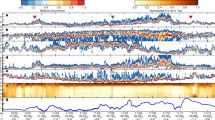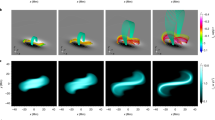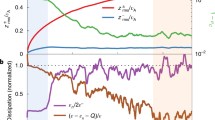Abstract
Supergranulation1,2 on the surface of the Sun is a pattern of horizontal outflows, outlined by a network of small magnetic features, with a distinct scale of 30 million metres and an apparent lifetime of one day. It is generally believed that supergranulation corresponds to a preferred ‘cellular’ scale of thermal convection; rising magnetic fields are dragged by the outflows and concentrated into ‘ropes’ at the ‘cell’ boundaries3. But as the convection zone is highly turbulent and stratified, numerical modelling has proved to be difficult and the dynamics remain poorly understood. Moreover, there is as yet no explanation for the observation that the pattern appears4,5 to rotate faster around the Sun than the magnetic features. Here we report observations showing that supergranulation undergoes oscillations and supports waves with periods of 6–9 days. The waves are predominantly prograde, which explains the apparent super-rotation of the pattern. The rotation of the plasma through which the pattern propagates is consistent with the motion of the magnetic network.
This is a preview of subscription content, access via your institution
Access options
Subscribe to this journal
Receive 51 print issues and online access
$199.00 per year
only $3.90 per issue
Buy this article
- Purchase on Springer Link
- Instant access to full article PDF
Prices may be subject to local taxes which are calculated during checkout




Similar content being viewed by others
References
Leighton, R. B., Noyes, R. W. & Simon, G. W. Velocity fields in the solar atmosphere. I. Preliminary report. Astrophys. J. 135, 474–499 (1962)
Simon, G. W. & Leighton, R. B. Velocity fields in the solar atmosphere. III. Large-scale motions, the chromospheric network, and magnetic fields. Astrophys. J. 140, 1120–1147 (1964)
Galloway, D. J. & Weiss, N. O. Convection and magnetic fields in stars. Astrophys. J. 243, 945–953 (1981)
Duvall, T. L. Jr The equatorial rotation rate of the supergranulation cells. Sol. Phys. 66, 213–221 (1980)
Snodgrass, H. B. & Ulrich, R. K. Rotation of Doppler features in the solar photosphere. Astrophys. J. 351, 309–316 (1990)
Scherrer, P. H. et al. The solar oscillations investigation—Michelson Doppler imager. Sol. Phys. 162, 129–188 (1995)
Duvall, T. L. Jr et al. Time-distance helioseismology. Nature 362, 430–432 (1993)
Duvall, T. L. Jr & Gizon, L. Time-distance helioseismology with f modes as a method for measurement of near-surface flows. Sol. Phys. 192, 177–191 (2000)
Schou, J. & Bogart, R. S. Flow and horizontal displacements from ring diagrams. Astrophys. J. 504, L131–L134 (1998)
Komm, R. W., Howard, R. F. & Harvey, J. W. Rotation rates of small magnetic features from two- and one-dimensional cross-correlation analyses. Sol. Phys. 145, 1–10 (1993)
Komm, R. W., Howard, R. F. & Harvey, J. W. Meridional flow of small photospheric magnetic features. Sol. Phys. 147, 207–223 (1993)
Beck, J. G. Large Scale Solar Velocities on Time Scales up to Thirty Days. Thesis, Univ. California (1997)
Beck, J. G. & Schou, J. Supergranulation rotation. Sol. Phys. 193, 333–343 (2000)
Brummell, N. H., Hurlburt, N. E. & Toomre, J. Turbulent compressible convection with rotation. I. Flow structure and evolution. Astrophys. J. 473, 494–513 (1996)
Miesch, M. S. et al. Three-dimensional spherical simulations of solar convection. I. Differential rotation and pattern evolution achieved with laminar and turbulent states. Astrophys. J. 532, 593–615 (2000)
Hurlburt, N. E., Matthews, P. C. & Proctor, M. R. E. Nonlinear compressible convection in oblique magnetic fields. Astrophys. J. 457, 933–938 (1996)
Zhong, F., Ecke, R. & Steinberg, V. Asymmetric modes and the transition to vortex structures in rotating Rayleigh-Bénard convection. Phys. Rev. Lett. 67, 2473–2476 (1991)
Walden, R. W. et al. Traveling waves and chaos in convection in binary fluid mixtures. Phys. Rev. Lett. 55, 496–499 (1985)
Acknowledgements
We thank D. O. Gough for suggestions about the general presentation of this Letter, and P. Milford, P. H. Scherrer, C. J. Schrijver and N. O. Weiss for comments. SOHO is a mission of international cooperation between the European Space Agency and NASA. MDI is supported by the Office of Space Sciences of NASA.
Author information
Authors and Affiliations
Corresponding author
Ethics declarations
Competing interests
The authors declare that they have no competing financial interests.
Rights and permissions
About this article
Cite this article
Gizon, L., Duvall, T. & Schou, J. Wave-like properties of solar supergranulation. Nature 421, 43–44 (2003). https://doi.org/10.1038/nature01287
Received:
Accepted:
Issue Date:
DOI: https://doi.org/10.1038/nature01287
This article is cited by
-
Waves in the lower solar atmosphere: the dawn of next-generation solar telescopes
Living Reviews in Solar Physics (2023)
-
Dynamics of Large-Scale Solar Flows
Space Science Reviews (2023)
-
Surface and interior meridional circulation in the Sun
Living Reviews in Solar Physics (2022)
-
The Sun’s supergranulation
Living Reviews in Solar Physics (2018)
-
Helioseismology with Solar Orbiter
Space Science Reviews (2015)
Comments
By submitting a comment you agree to abide by our Terms and Community Guidelines. If you find something abusive or that does not comply with our terms or guidelines please flag it as inappropriate.



